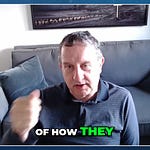SaaStr CEO Jason Lemkin joined ZoomInfo’s as its opening guest alongside ZoomInfo CEO Henry Schuck.
Along with co-host Ben Salzman, Jason and Henry discuss the transformative power of AI within SaaS and the evolving dynamics that are reshaping the landscape of software as a service.
There’s recruiting and there’s people building.
On the topic of building SaaS companies, Henry kicks off the conversation with: “I think a lot of bootstrapped founders who are less capital infused have to actually be great at developing their people. Almost equally to their ability to recruit great people. I bootstrapped ZoomInfo to 25 million in revenue. And then when I brought in private equity, it wasn’t like, ‘Go spend everything you can to grow.’ They’re like, ‘This thing looks good. Spend a little more and make it twice as big.'”
Without a big budget to get the best people, Henry believes part of the ZoomInfo difference has been recruiting good people that he then fostered and developed into great people.
“The best hack,” Jason adds, “is not recruiting one management team. It’s recruiting five or six.”
Founders should spend 20-30 percent of their time soft recruiting execs. Nothing else matters, right? You can talk about the roadmap or sales strategy until you’re blue in the face, but if you don’t have the team to do it at scale, there’s no point in talking a ‘big game.’
Henry adds: “The other side of it is. You need to be evaluating your team 100 percent of the time. And that’s probably the most tiring part because you want to feel really good about your team. But if you’re trying to build, you’re constantly evaluating if they’re the right people.”
The best sales leaders are the ones that are even better recruiters than the CEO. The best VP of sales or CRO is a constant recruiter because they need a bench of leaders, and they need managers and directors, and VPs and SVPs to come and go in the mix because the sales reps who might be good at $1m won’t scale to 10-20 M. So founders need to steal this playbook and get better at this.
Otherwise, if you get tired on building your second management team, you’ll decelerate just when it’s getting good and you will stall out.
It’s mission-critical to go multiproduct on time — too early is bad but too late is bad too
We’ve written this up already a few times recently on SaaStr already as Jason did a deep dive on this just last week and Parker Conrad’s theory of the compound startup from SaaStr Europa is a masterclass on the matter. But the next point related to not building a second management team early enough is not going multiproduct soon enough.
On going multi-product Henry adds, “I think the foundational point is if you want high net retention, you get high net retention in two ways. Either a high net renewal rate or a high upsell into the customer base. And particularly during the last two years, if teams are shrinking then you don’t have the users to expand to. And so then you end up with no lever to offset scrutiny on net renewal rate or reduction in seats with another product to improve net retention.”
For example, when you hit a $100M, you just can’t sell enough to drive 40 points of new growth. Even if your net retention is a hundred, itt’s much more difficult to sell $40 million of net new logos. So eventually you’ll get to a point where regardless of how good your team is at new sales, if you’re not driving upsell in your customer base through new products, you will get stuck.
Don’t Hire B Players, Only Hire A Players
Ben Salzman, co-host of the ZI labs podcast and EVP & GM Strategy at ZoomInfo asks Jason:
‘(At Echosign) What was the one thing that allowed you all to punch above your weight from a go-to-market perspective?’
“The answer is so simple, but it really is that the best leaders do attract the most ambitious people under them.”
If you hire a magnet, then the talent just flocks to it. Don’t hire B players, just hire A players.
And sure, founders know that, but the point is that you have to internalize being OK with it taking way longer than you wanted to get the next great person in seat.
We give up too early Henry explains. “You’re hiring a new VP of sales and you’re on your 20th interview. And then you’re just like, ‘Forget it. That guy’s the best of everybody I’ve seen.’ But he’s not the best, he just the best of everybody you’ve seen. So you just get this guy who’s the best of the group you’ve met and bring him in, and that never ever works. And the real test, if you are going to be committed to hiring an A team is in that moment saying, ‘We’re still going. We just got to keep bringing people in until we find somebody that we really believe is an A player.”
What Will AI Change in Go-to-Market
“It will lead to a next level of transparency for leadership,” Jason answers. It will be a big change and a lot of friction.
Everything in post-sales is ahead of sales when it comes to AI, far ahead. For years there’s been a QA space where businesses were manually grading thousands of customer success agents. And AI has completely ripped through the space. Now, everything has AI in QA. If I have a thousand folks picking up the phone you’re not going to grade them manually anymore. AI can just injest all your data and tell you who’s got to go or stay.
Everything we’re talking about in sales and AI has already happened post-sales. And part of that is this transparency that doesn’t exist today.
So if you want to see where AI is going in sales, just pop over to post-sales.
“It’s already happened,” Jason explains. “If you look at the homepage of everyone doing customer support software, like Zendesk, Intercom, or Gorgias and you squint, you know what they all say?
That — in essence — you can lay off 40 percent of your support team.
We can argue whether that works in sales or not, but it’s the same. It’s just, that there’s more pull in post-sales. So we should learn from it in sales for leadership, for transparency, for product, because here’s your crystal ball. It’s not quite going to work in sales the same way, but it’s the same tsunami that’s going to come.”









